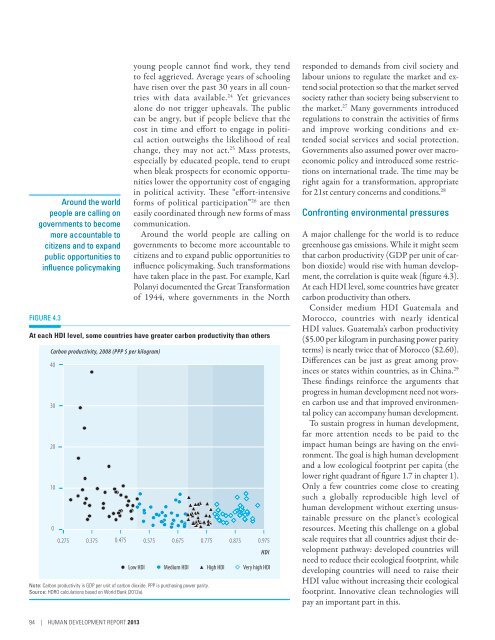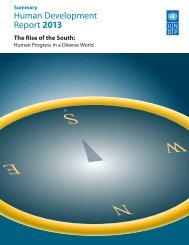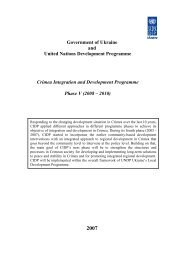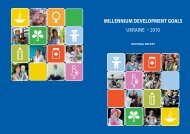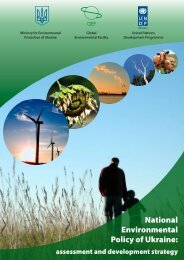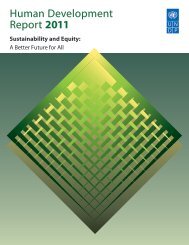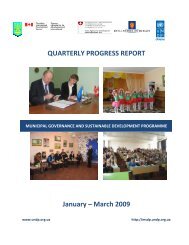E N S W - United Nations Development Programme
E N S W - United Nations Development Programme
E N S W - United Nations Development Programme
You also want an ePaper? Increase the reach of your titles
YUMPU automatically turns print PDFs into web optimized ePapers that Google loves.
Around the world<br />
people are calling on<br />
governments to become<br />
more accountable to<br />
citizens and to expand<br />
public opportunities to<br />
influence policymaking<br />
Figure 4.3<br />
young people cannot find work, they tend<br />
to feel aggrieved. Average years of schooling<br />
have risen over the past 30 years in all countries<br />
with data available. 24 Yet grievances<br />
alone do not trigger upheavals. The public<br />
can be angry, but if people believe that the<br />
cost in time and effort to engage in political<br />
action outweighs the likelihood of real<br />
change, they may not act. 25 Mass protests,<br />
especially by educated people, tend to erupt<br />
when bleak prospects for economic opportunities<br />
lower the opportunity cost of engaging<br />
in political activity. These “effort- intensive<br />
forms of political participation” 26 are then<br />
easily coordinated through new forms of mass<br />
communication.<br />
Around the world people are calling on<br />
governments to become more accountable to<br />
citizens and to expand public opportunities to<br />
influence policymaking. Such transformations<br />
have taken place in the past. For example, Karl<br />
Polanyi documented the Great Transformation<br />
of 1944, where governments in the North<br />
At each HDI level, some countries have greater carbon productivity than others<br />
Carbon productivity, 2008 (PPP $ per kilogram)<br />
40<br />
30<br />
20<br />
10<br />
0<br />
0.275 0.375 0.475 0.575 0.675 0.775 0.875 0.975<br />
Low HDI<br />
Medium HDI<br />
Note: Carbon productivity is GDP per unit of carbon dioxide. PPP is purchasing power parity.<br />
Source: HDRO calculations based on World Bank (2012a).<br />
High HDI<br />
HDI<br />
Very high HDI<br />
responded to demands from civil society and<br />
labour unions to regulate the market and extend<br />
social protection so that the market served<br />
society rather than society being subservient to<br />
the market. 27 Many governments introduced<br />
regulations to constrain the activities of firms<br />
and improve working conditions and extended<br />
social services and social protection.<br />
Governments also assumed power over macroeconomic<br />
policy and introduced some restrictions<br />
on international trade. The time may be<br />
right again for a transformation, appropriate<br />
for 21st century concerns and conditions. 28<br />
Confronting environmental pressures<br />
A major challenge for the world is to reduce<br />
greenhouse gas emissions. While it might seem<br />
that carbon productivity (GDP per unit of carbon<br />
dioxide) would rise with human development,<br />
the correlation is quite weak (figure 4.3).<br />
At each HDI level, some countries have greater<br />
carbon productivity than others.<br />
Consider medium HDI Guatemala and<br />
Morocco, countries with nearly identical<br />
HDI values. Guatemala’s carbon productivity<br />
($5.00 per kilogram in purchasing power parity<br />
terms) is nearly twice that of Morocco ($2.60).<br />
Differences can be just as great among provinces<br />
or states within countries, as in China. 29<br />
These findings reinforce the arguments that<br />
progress in human development need not worsen<br />
carbon use and that improved environmental<br />
policy can accompany human development.<br />
To sustain progress in human development,<br />
far more attention needs to be paid to the<br />
impact human beings are having on the environment.<br />
The goal is high human development<br />
and a low ecological footprint per capita (the<br />
lower right quadrant of figure 1.7 in chapter 1).<br />
Only a few countries come close to creating<br />
such a globally reproducible high level of<br />
human development without exerting unsustainable<br />
pressure on the planet’s ecological<br />
resources. Meeting this challenge on a global<br />
scale requires that all countries adjust their development<br />
pathway: developed countries will<br />
need to reduce their ecological footprint, while<br />
developing countries will need to raise their<br />
HDI value without increasing their ecological<br />
footprint. Innovative clean technologies will<br />
pay an important part in this.<br />
94 | HUMAN DevELOPMENT REPORT 2013


